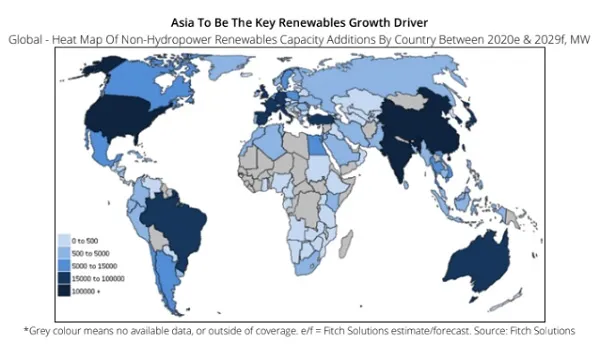
Asia Pacific's renewables to expand 800GW in the next decade
China is expected to make up 42% of the total global additions.
Renewables growth in the Asia Pacific region is projected to expand by over 800GW from 2020 to 2029, the fastest rate compared to any other region across the globe combined, according to Fitch Solutions.
China is expected to be the main driver of this capacity growth, making up about 42% of the total global additions. The country’s renewable energy is expected to continue registering cost deflations, making the sector more attractive on a cost-basis relative.
“This is in line with Beijing's ongoing efforts to reduce its heavy reliance on coal-fired power generation, and to boost China's renewables utilisation rates. China has taken aggressive steps to reduce grid bottlenecks and renewables curtailment, which has already seen substantial reductions in the last two years,” the report stated.
Also read: 150 GW of renewables in Asia Pacific at risk if recession stretches
Fitch is also bullish about India's renewables industry due to strong government support and the falling cost of renewables, which has grown cost-competitive with coal in the country.
“Regulatory incentives at both the Central and State levels, including subsidy schemes, financing mechanisms, utility quotas, tax incentives, net metering and other favourable policies such as grid access have been successful in mobilising investment into the industry and the project pipeline has strengthened accordingly, most notably for solar,” the report noted.
Distributed resources, notably rooftop solar, is tipped to play an increasingly dominant role in driving renewables expansion in Australia. Attractive state-level policies, coupled with falling technology costs and high retail electricity prices incentivising self-generation, boosted distributed solar PV capacity over the last decade.
In Taiwan, offshore wind is seeing support from the government, which viewed renewables as one of the key strategies to offset a reduction in nuclear and coal-fired output. Currently, it has more than 7.8GW of offshore wind capacity in the pipeline.
Globally, total non-hydro renewables capacity is projected to double over the coming decade, totalling over 2600GW by 2029. Solar power is expected to be the main driver of this growth, comprising 740GW of capacity additions, exceeding the 550GW expected for wind power.













 Advertise
Advertise











